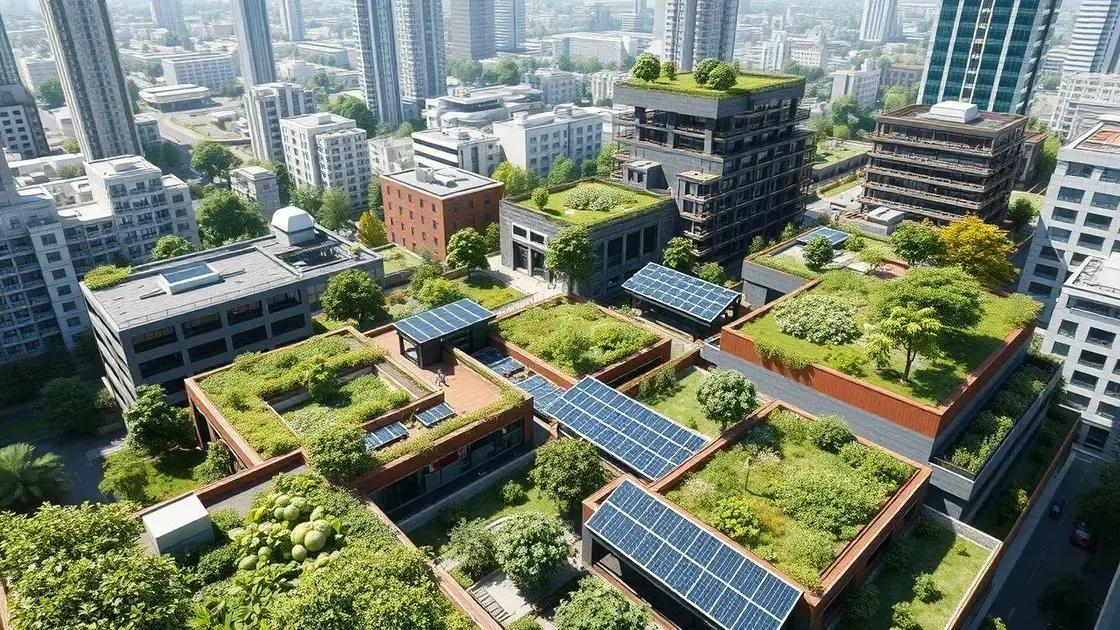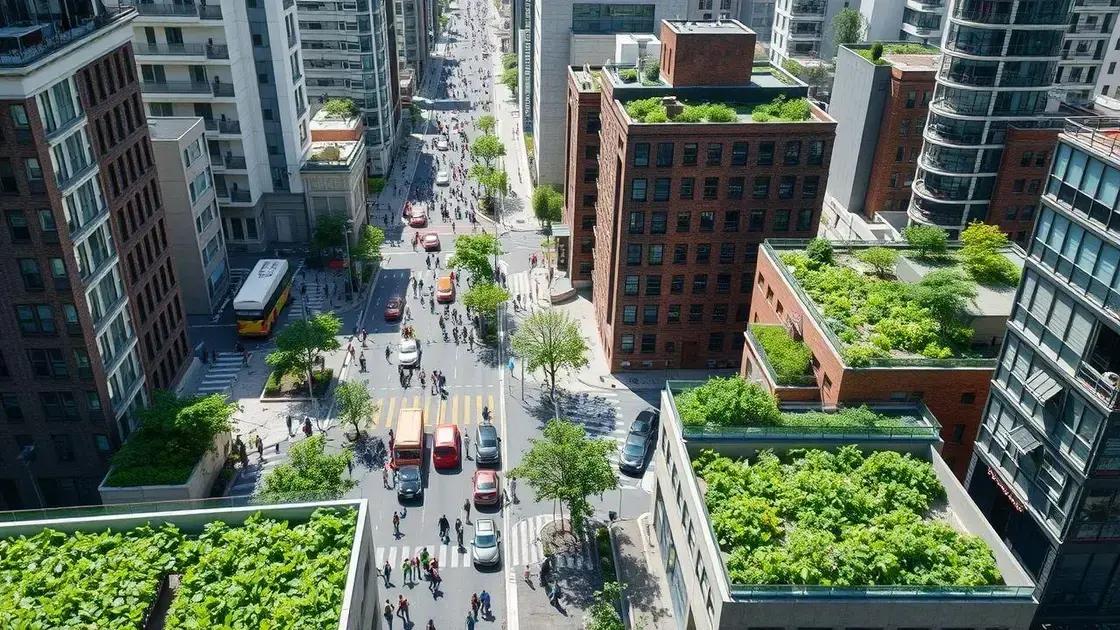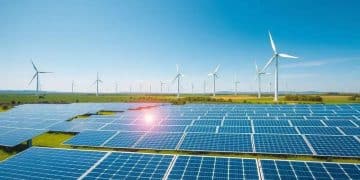Insights on green infrastructure headlines: What you need to know

Green infrastructure enhances urban environments by managing stormwater, improving air quality, and providing social benefits, despite challenges like funding and maintenance.
Insights on green infrastructure headlines are essential for anyone interested in sustainable development. Green infrastructure plays a crucial role in enhancing urban environments, addressing issues from climate change to biodiversity. Have you ever wondered how these solutions can reshape our cities?
Understanding green infrastructure
Understanding green infrastructure is essential for creating sustainable cities. It encompasses various practices that help manage stormwater, reduce heat, and improve air quality.
This approach integrates natural systems into urban environments. It can range from urban parks and green roofs to permeable pavements that allow rainwater to soak into the ground.
Key Components of Green Infrastructure
To fully grasp the concept, let’s explore some primary components:
- Green roofs: These are layered systems that include vegetation, soil, and drainage. They provide insulation and reduce runoff.
- Rain gardens: Shallow depressions planted with native plants that absorb rainwater. They are designed to filter pollutants and manage stormwater.
- Urban forests: Trees planted in cities that improve air quality and provide shade. They help combat the heat island effect.
Implementing green infrastructure can greatly enhance our quality of life. It promotes biodiversity and creates more enjoyable outdoor spaces.
Benefits of Understanding Green Infrastructure
Grasping how these components work together can help us advocate for better urban planning.
Moreover, communities that embrace green infrastructure often see lower energy costs and improved public health. This holistic approach can lead to resilient and thriving urban environments.
Benefits of green infrastructure in cities

The benefits of green infrastructure in cities are significant. These systems help manage stormwater, improve air quality, and create healthier urban spaces.
By integrating nature into urban planning, cities can reduce flooding and lower temperatures. Green spaces also enhance the aesthetic appeal of neighborhoods. This leads to well-being for residents and attracts more visitors.
Key Advantages of Green Infrastructure
Let’s highlight some key advantages:
- Flood mitigation: Green roofs and permeable pavements absorb rainwater, preventing runoff.
- Improved air quality: Trees and plants filter pollutants, ensuring cleaner air.
- Heat reduction: Green areas provide shade, helping to lower urban temperatures.
- Enhanced biodiversity: Urban nature spaces support wildlife and promote ecosystem health.
These benefits contribute to a better quality of life. Each of these factors plays a crucial role in promoting healthier communities.
Moreover, as cities adapt to climate change, green infrastructure becomes even more vital. Investing in these projects can lead to long-term savings and increased property values. Additionally, they foster social cohesion by enabling community engagement in environmental efforts.
Case studies of successful green projects
Case studies of successful green projects provide valuable insights into the impact of green infrastructure. These real-world examples showcase how cities have successfully integrated nature into urban designs.
One notable example is the High Line in New York City. This elevated park transformed an old railway into a vibrant green space. It not only enhanced the city’s beauty but also improved local biodiversity and attracted millions of visitors.
Noteworthy Green Projects
Here are some other successful transformations:
- Millennium Park in Chicago: Features extensive gardens and green roofs. It has become a central gathering place for residents and tourists alike.
- Rain Vortex in Singapore: The world’s tallest indoor waterfall incorporates rainwater harvesting while providing a lush environment in urban settings.
- Birmingham’s Green Homes: An initiative that retrofitted homes to include green roofs and solar panels, demonstrating sustainability in residential areas.
These projects illustrate how green infrastructure can revitalize urban spaces. They also promote community engagement and environmental stewardship. By highlighting these successful cases, we can inspire more cities to adopt similar initiatives.
Additionally, such projects often lead to economic benefits. They attract new businesses, increase property values, and boost tourism. By analyzing these successes, other cities can learn effective strategies for enhancing their own green infrastructure.
Challenges and future of green infrastructure

The challenges and future of green infrastructure are crucial topics in urban planning. While there are many benefits, implementing these systems is not always straightforward.
One major challenge is funding. Cities often struggle to allocate budget for green infrastructure projects. Many believe that these initiatives come with high upfront costs, which can deter potential investments.
Key Challenges Faced
Several factors complicate the growth of green infrastructure:
- Limited space: In densely populated areas, finding room for new green projects can be difficult.
- Maintenance issues: Once installed, these systems require ongoing care to remain effective and aesthetically pleasing.
- Lack of awareness: Not everyone understands the benefits of green infrastructure, which can lead to less community support.
Despite these challenges, the future of green infrastructure is promising. As cities recognize the importance of sustainability, more initiatives are being planned. Innovative designs are emerging that combine technology with natural systems.
Moreover, increasing public awareness about climate change is pushing local governments to invest more in green solutions. This growing trend gives hope for more resilient urban environments. By overcoming existing obstacles, cities can create healthier, more livable spaces.
FAQ – Frequently Asked Questions about Green Infrastructure
What is green infrastructure?
Green infrastructure refers to natural and semi-natural systems that manage stormwater, enhance air quality, and improve urban living.
How does green infrastructure benefit cities?
It provides multiple benefits, including flood mitigation, improved public health, and increased biodiversity in urban environments.
What are the challenges in implementing green infrastructure?
Challenges include funding, limited space, ongoing maintenance, and a lack of awareness among community members.
What is the future of green infrastructure?
The future looks promising as cities increasingly recognize its importance for sustainability and resilience in the face of climate change.






